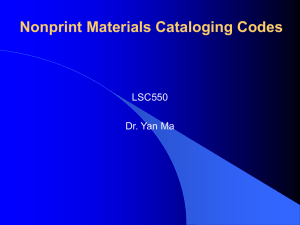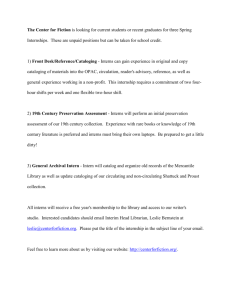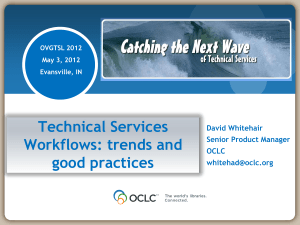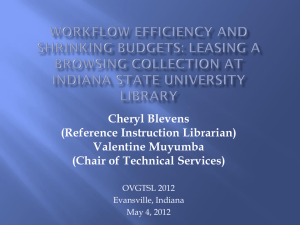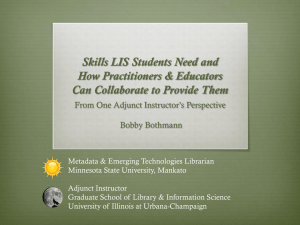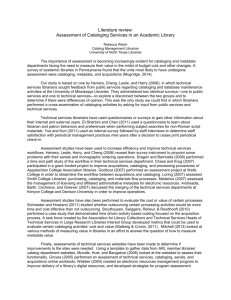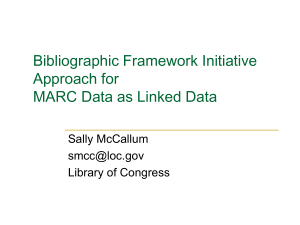LIB5030101101 - Syllabi - Appalachian State University
advertisement
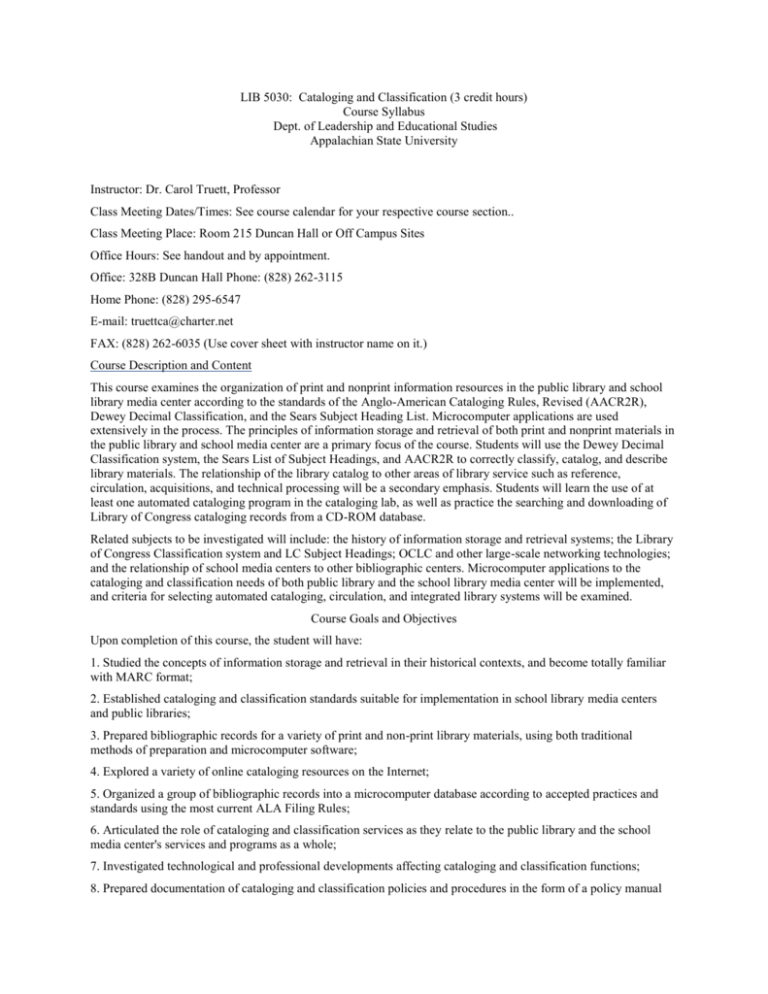
LIB 5030: Cataloging and Classification (3 credit hours) Course Syllabus Dept. of Leadership and Educational Studies Appalachian State University Instructor: Dr. Carol Truett, Professor Class Meeting Dates/Times: See course calendar for your respective course section.. Class Meeting Place: Room 215 Duncan Hall or Off Campus Sites Office Hours: See handout and by appointment. Office: 328B Duncan Hall Phone: (828) 262-3115 Home Phone: (828) 295-6547 E-mail: truettca@charter.net FAX: (828) 262-6035 (Use cover sheet with instructor name on it.) Course Description and Content This course examines the organization of print and nonprint information resources in the public library and school library media center according to the standards of the Anglo-American Cataloging Rules, Revised (AACR2R), Dewey Decimal Classification, and the Sears Subject Heading List. Microcomputer applications are used extensively in the process. The principles of information storage and retrieval of both print and nonprint materials in the public library and school media center are a primary focus of the course. Students will use the Dewey Decimal Classification system, the Sears List of Subject Headings, and AACR2R to correctly classify, catalog, and describe library materials. The relationship of the library catalog to other areas of library service such as reference, circulation, acquisitions, and technical processing will be a secondary emphasis. Students will learn the use of at least one automated cataloging program in the cataloging lab, as well as practice the searching and downloading of Library of Congress cataloging records from a CD-ROM database. Related subjects to be investigated will include: the history of information storage and retrieval systems; the Library of Congress Classification system and LC Subject Headings; OCLC and other large-scale networking technologies; and the relationship of school media centers to other bibliographic centers. Microcomputer applications to the cataloging and classification needs of both public library and the school library media center will be implemented, and criteria for selecting automated cataloging, circulation, and integrated library systems will be examined. Course Goals and Objectives Upon completion of this course, the student will have: 1. Studied the concepts of information storage and retrieval in their historical contexts, and become totally familiar with MARC format; 2. Established cataloging and classification standards suitable for implementation in school library media centers and public libraries; 3. Prepared bibliographic records for a variety of print and non-print library materials, using both traditional methods of preparation and microcomputer software; 4. Explored a variety of online cataloging resources on the Internet; 5. Organized a group of bibliographic records into a microcomputer database according to accepted practices and standards using the most current ALA Filing Rules; 6. Articulated the role of cataloging and classification services as they relate to the public library and the school media center's services and programs as a whole; 7. Investigated technological and professional developments affecting cataloging and classification functions; 8. Prepared documentation of cataloging and classification policies and procedures in the form of a policy manual appropriate for either a public or school library; 9. Evaluated sources of commercially prepared cataloging; 10. Studied and implemented use of standard cataloging and classification tools such as AACR2R, Dewey classification, Sears List, and the ALA Filing Rules. 11. Researched a variety of people, networks, and services (e.g., sources of MARC records, materials processing, etc.) important in cataloging and technical processing. Recommended Bibliography/Textbooks/References/Readings: +Highly recommended. *Required texts or cataloging tools. Taylor, Arlene G. Wynar’s Introduction to Cataloging and Classification, 9th ed.. Englewood, Colo.: Libraries Unlimited, 2000. +Anglo-American Cataloguing Rules, Second Edition, 2002 Revision, 2004 and 2005 Updates. (AACR2R) Chicago: ALA, 2004. *Miller, Joseph, ed. Sears List of Subject Headings. 19th ed. New York: H.W. Wilson, 2007. ISBN: 978-0-82421076-2 *Abridged Dewey Decimal Classification and Relative Index. 14th ed. Dublin, Ohio: OCLC, 2004. ISBN: 0910608-73-3 See http://www.oclc.com/dewey/products/index.htm for order information. Dewey Decimal Classification and Relative Index. 22nd ed. Dublin, Ohio: OCLC, 2003. See http://www.oclc.com/dewey/products/index.htm for order information. *McCroskey, Marilyn. Cataloging Nonbook Materials with AACR2R and MARC: A Guide for the School Library Media Specialist--2nd Edition. Chicago: AASL/ALA: 1999. Now out of print. *Intner, Shelia S. and Weihs, Jean. Standard Cataloging for School and Public Libraries. 4th ed. Englewood, Colo.: Libraries Unlimited, 2007. ISBN-13: 978-1-59158-378-3 +American Library Association. ALA Filing Rules. Chicago: ALA, 1980. Or: check for most current edition. Bowman, J.H. Essential Cataloguing. London: Facet Publishing, 2003. Chan, Lois Mai and Mitchell, Joan S. Dewey Decimal Classification: Principles and Application. 3rd ed. Dublin, Ohio: OCLC, 2003. Hsieh-Yee, Ingrid. Organizing Audiovisual and Electronic Resources for Access: A Cataloging Guide. Englewood, Colo.: Libraries Unlimited, 2000. Workbook: *Davis, Sydney W. and New, Gregory R. Abridged 13 Workbook: For Small Libraries Using Dewey Decimal Classification Abridged Edition 13. Albany, N.Y.: Forest Press, OCLC, 1997. Now out of print. Computer Laboratory Use: You may use the Computer Lab at ASU in Duncan Hall, Room 215 in Boone to complete assignments, the off campus lab where you are taking the course, or otherwise you MUST have the Follett cataloging software installed in your school. PLEASE NOTE: IT WILL BE IMPOSSIBLE TO DO THE WORK FOR THIS COURSE WITHOUT THIS ACCESSIBILITY. The instructor does accept other automation system's MARC records with prior approval pending an examination of a sample record. NOTE: All students in this class as well as all other Extension classes must have an e-mail account which is currently working; you MUST provide your instructor with your e-mail account user name or ID if you are not using the one provided by ASU on campus. It will be necessary to check your E-Mail account at least once or twice a week, and daily during the summer or every few hours during inclement weather in case of an emergency cancellation of class due to weather conditions. Check the inclement weather policy later in this syllabus. Supplies: Double-sided, high density floppy disks--at least two--formatted for Windows computers. Please bring to ANY SCHEDULED class for every session. Computer Software: We will be using Follett’s Library Automation Solutions Windows software, and especially the Cataloging, Alliance Plus, and OPAC components of this program in the Computer Labs. Lib. 5030 Cataloging and Classification Course Assignments and Requirements 1. Cataloging Exercises You will be required to completely catalog a minimum of 8 items, including 5 print and 3 non-print items. These need to be done using original cataloging and Follett's Cataloging program in MARC format. You may also be expected to search for, customize, and download a number of LC cataloging records from a CD-ROM database such as Alliance Plus or other similar programs. Records turned in must include the proof sheets (MARC format), plus a typed copy of the record itself in full OPAC form (no hand printed records will be accepted). Part One For the first part of this assignment, you will turn in two print items completely cataloged. Your professor will supply you with these first two books. This cataloging includes Dewey Classification numbers, Sears subject headings, and Level 2 descriptive cataloging. Each record is worth 100 total points. (100 X 2 = 200) 200 Total Points Part Two Complete cataloging for your remaining 3 print items is required for this part of the cataloging exercise. Also, make corrections to your original print items (for which you will get 1/2 of all credit missed back after you make the corrections). Be sure to turn in your original two graded items for credit on this as I will not completely regrade the work--only the corrections. Each record is worth 50 total points. (50 X 3 = 150) 150 Total Points Part Three Complete cataloging for 3 non-print items is required for the final part of the practice cataloging exercise. You must catalog 1 video recording, 1 sound recording (i.e., music audio CD or cassette or talking book, etc.), and 1 compact disc (which must be a computer file, NOT an audio CD). These will be supplied by you. Please do not turn in valuable non-print items for this exercise in case they somehow become misplaced although every precaution will be taken to keep the items safe until they are picked up after grading. Do NOT USE THE JUMP*START CD ROM Series for this assignment. Each record is worth 50 total points. (50 X 3 = 150) 150 Total Points Link to Grading for Cataloging Exercises Above 2. Exams There may be 2 course exams. Each is worth 200 points. 2 tests X 200 = 400 points Each student will write a paper on RDA (Resource Description and Access) the new cataloging rules. Worth 200 points. Those taking the course over the Web will have to identify by name and title their proctor at their local site, and send this person's name, title and telephone number, as well as their full mailing address, to Dr. Truett two weeks before the first exam. Examples of appropriate proctors are your school principal, your library director, or your district media coordinator. Be sure you provide a "reachable" phone number for the individual as I will be calling them ahead of time to verify that they are willing to proctor and then to make sure they have the exam. They must have an official position and be willing to supervise your taking of the exams, plus certify that no inappropriate help was provided (e.g., textbooks when it was closed book, going onto the web to find answers, consulting notes if not permitted, etc.). 600 Total Points 3. Authority File Exercise This will be done using online and manual sources in the library. Read the appropriate sections in your text and other sources concerning the need for authority files. Then prepare authority records for the persons and organizations below. Cite AACR2R rule(s) for each type of name and be sure it corresponds to the form of the name you have chosen. The following names are for practice only. There will be names on one of the exams for which you must select the correct form and cite an appropriate AACR2R rule. We will either discuss this assignment and the correct answers on the web or in class, depending on your mode of course delivery. Answer the odd numbered names by using the Library of Congress online catalog as an authority file and the even ones by using manual print sources. Or, we may answer all of these using the LC online authority file. 1. Your professor 2. Avi (childrens/YA author) 3. Princess Diana 4. the Internal Revenue Service 5. William Shakespeare 6. Elizabeth Peters [mystery author] 7. Dr. Ruth 8. Lewis Carroll 9. Thoreau 10. Cher Use the following elements in your authority file: 1. The PROPER NAME TO BE USED, birth and death dates if applicable [especially if person is of significance]. 2. Citation to source of confirming information [One is sufficient for this exercise; abbreviate as appropriate. If found on the LC (Library of Congress) Authority File, simply say LC.]. 3. Form(s) of names not used. Indicate by small "x". [Indicates need for a cross reference card within the catalog.] You must include at least one cross reference for every name. 4. AACR2R applicable rule(s). Number(s) only is sufficient. Thus, a reference for Mark Twain might look like this: 1. Twain, Mark, 1835-1910. 2. American Heritage College Dictionary, 3rd ed. Boston: Houghton Mifflin, 1997. P. 261. 3. x Clemens, Samuel Langhorne. [An "x" in cataloging means DO NOT USE the term following it.] It is a cross reference. 4. AACR2R Rule Number(s): Cite rule number dealing with entry under pseudonym. Record your authority decisions here. Copy this and turn in for this assignment. Authority Control Exercise 1. Name: Source: x AACR2R Rule(s) 2. Name: Source: x AACR2R Rule(s) 3. Name: Source: x AACR2R Rule(s) 4. Name: Source: x AACR2R Rule(s) 5. Name: Source: x AACR2R Rule(s) 6. Name: Source: x AACR2R Rule(s) 7. Name: Source: x AACR2R Rule(s) 8. Name: Source: x AACR2R Rule(s) 9. Name: Source: x AACR2R Rule(s) 10. Name: Source: x AACR2R Rule(s) Credit/No credit on this assignment but must be turned in. 4. Filing Exercise Check the library science web page for information on the ALA Filing Rules: http://www.les.appstate.edu/libsci/alafiling.html There may be a filing exercise on one of the exams. 5. Participation, Daily or Weekly Assignments, and Discussion Groups 300 Total Points Includes Network OR Biography Report (at 100 points) and weekly CHAT sessions, plus other weekly assignments. Your instructor may not always be in on the CHAT session but you will still get credit for participation. You must be online for at least 20-30 minutes to get credit. Keep track of your dates and times as you will have to turn them in at the end of the course to receive this credit. The instructor will keep track of participants periodically. The instructor will introduce topics for discussion, as may students, and you may ask questions about assignments, etc., during the CHAT sessions. 6. Cataloging Policy Manual Further instructions and a handout list of suggested topics will be provided for this assignment. 200 Points Total Points for Course 1600 Total Points Evaluation and Grading: Assignments are subject to a 5% reduction in grade for each class period that they are turned in past the due date. For exact grade points for each assignment, see above requirement descriptions and summary below. Final grades will be based on the following scale: A 95-100% C+ 77-79% A- 90-94% C 73-76% B+ 87-89% C- 70-72% B 83-86% F 69-0% B- 80-82% Note: No final grade of D may be assigned in Graduate School so it is not included in the above grading scale. Important: No assignments will be accepted after the last day of class unless specifically stated otherwise. In the case of class presentations, I must be informed in advance (at least 24 hours) if an assignment will be turned in or presented late. Consistent tardiness in assignments will result in your grade being penalized. Also, two or more missed classes will result in a grade reduction. Incompletes will not be given for this course except under the most unusual circumstances. This only includes such circumstances as death in the family, divorce, fatal or chronic illness, etc. Please refer to your student bulletin for university policy on such matters. Also, please understand that a student does not opt to "take" an Incomplete. All grades are assigned by the instructor. Inclement Weather Policy: Please refer to the appropriate university inclement weather policy. Classes at ASU are only postponed (and then rescheduled) due to weather problems as a last resort. This professor will notify students in this and all other classes if a class is cancelled through the following three means: 1. By means of the Telephone Tree which will be established for each section of the class. 2. Through students' E-Mail accounts no later than three hours before a class is cancelled. 3. By having students call her at home (828) 295-6547 or the LES department office (828) 262-3115 or (828) 262-2243 no later than two hours before the class is scheduled. Appalachian State local weather can be checked by calling (828) 262-SNOW. Because the office personnel will not personally call and notify individual students, please do not expect to receive a personal phone call if a class is cancelled. It is your responsibility to check your E-Mail account, your phone messages at home and/or work (including answering machines) or phone your professor. Also, please be aware that weather conditions vary widely throughout North Carolina and you must use your own best judgment when traveling to and from classes. If you feel that your life or personal safety is being threatened by weather conditions, you may need to individually cancel your travel plans to attend a particular class even thought it may not be postponed. An entire class cancelled will be rescheduled toward the end of the semester. An individual class missed by any student due to weather conditions must be made up individually. The professor respects individual judgments in these cases and will make every effort to help a student make up missed work. Methods of Teaching Lectures, Internet home page assignments, field trips, guest speakers, computer laboratory practice hands-on, Internet searching and cataloging resources, original and copy cataloging, assigned readings, student oral reports, CD-ROM LC record searching and downloading, hands-on practice with the Follett library automation system, online chat sessions, listservs, and class discussion will all be used as teaching methods in this course.

